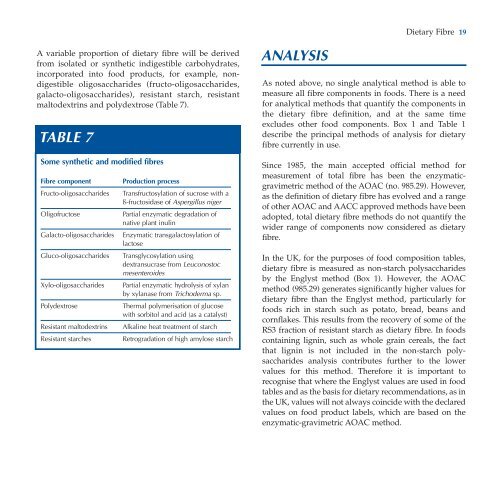Dietary Fibre - ILSI Argentina
Dietary Fibre - ILSI Argentina
Dietary Fibre - ILSI Argentina
Create successful ePaper yourself
Turn your PDF publications into a flip-book with our unique Google optimized e-Paper software.
<strong>Dietary</strong> <strong>Fibre</strong> 19<br />
A variable proportion of dietary fibre will be derived<br />
from isolated or synthetic indigestible carbohydrates,<br />
incorporated into food products, for example, nondigestible<br />
oligosaccharides (fructo-oligosaccharides,<br />
galacto-oligosaccharides), resistant starch, resistant<br />
maltodextrins and polydextrose (Table 7).<br />
TABLE 7<br />
Some synthetic and modified fibres<br />
<strong>Fibre</strong> component<br />
Fructo-oligosaccharides<br />
Oligofructose<br />
Galacto-oligosaccharides<br />
Gluco-oligosaccharides<br />
Xylo-oligosaccharides<br />
Polydextrose<br />
Resistant maltodextrins<br />
Resistant starches<br />
Production process<br />
Transfructosylation of sucrose with a<br />
ß-fructosidase of Aspergillus niger<br />
Partial enzymatic degradation of<br />
native plant inulin<br />
Enzymatic transgalactosylation of<br />
lactose<br />
Transglycosylation using<br />
dextransucrase from Leuconostoc<br />
mesenteroides<br />
Partial enzymatic hydrolysis of xylan<br />
by xylanase from Trichoderma sp.<br />
Thermal polymerisation of glucose<br />
with sorbitol and acid (as a catalyst)<br />
Alkaline heat treatment of starch<br />
Retrogradation of high amylose starch<br />
ANALYSIS<br />
As noted above, no single analytical method is able to<br />
measure all fibre components in foods. There is a need<br />
for analytical methods that quantify the components in<br />
the dietary fibre definition, and at the same time<br />
excludes other food components. Box 1 and Table 1<br />
describe the principal methods of analysis for dietary<br />
fibre currently in use.<br />
Since 1985, the main accepted official method for<br />
measurement of total fibre has been the enzymaticgravimetric<br />
method of the AOAC (no. 985.29). However,<br />
as the definition of dietary fibre has evolved and a range<br />
of other AOAC and AACC approved methods have been<br />
adopted, total dietary fibre methods do not quantify the<br />
wider range of components now considered as dietary<br />
fibre.<br />
In the UK, for the purposes of food composition tables,<br />
dietary fibre is measured as non-starch polysaccharides<br />
by the Englyst method (Box 1). However, the AOAC<br />
method (985.29) generates significantly higher values for<br />
dietary fibre than the Englyst method, particularly for<br />
foods rich in starch such as potato, bread, beans and<br />
cornflakes. This results from the recovery of some of the<br />
RS3 fraction of resistant starch as dietary fibre. In foods<br />
containing lignin, such as whole grain cereals, the fact<br />
that lignin is not included in the non-starch polysaccharides<br />
analysis contributes further to the lower<br />
values for this method. Therefore it is important to<br />
recognise that where the Englyst values are used in food<br />
tables and as the basis for dietary recommendations, as in<br />
the UK, values will not always coincide with the declared<br />
values on food product labels, which are based on the<br />
enzymatic-gravimetric AOAC method.

















